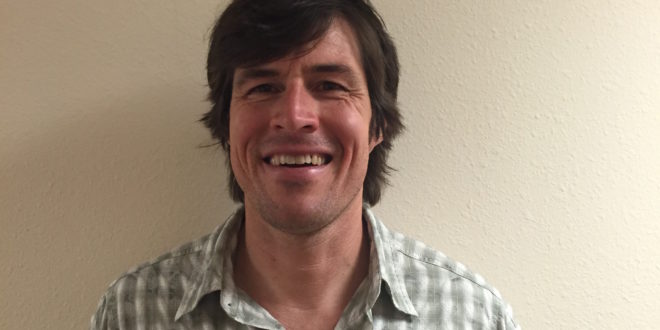“The least studied mammal in Yellowstone is humans,” says Yellowstone National Park’s Social Science Coordinator Ryan Atwell.
Atwell is the Park’s first full-time social scientist, hired not just to study how humans interact with Yellowstone but to also create a social science program that will meld visitor use with protecting one of the largest intact temperate zone ecosystems in the world.
Visitation up 14 percent in 2015
Atwell, 37, came to Yellowstone last August, and was almost immediately tasked with studying how Park managers could best adapt to a large and rapid increase in visitation to the park.
“Yellowstone saw a 14 percent increase in visitation between 2014 and 2015,” Atwell said.
Park visitation crested the 4 million mark for the first time in 2015. The trend continues this year, with more people than ever expected to visit-thanks to the National Park Service centennial this year.
Anecdotally, the perception is that there are more visitors from East Asia, including India and China. Atwell hopes to be able to quantify this perception with data.
As those countries’ economies continue to expand, a new and more affluent middle class has the financial resources to travel abroad for the first time.
“Yellowstone is on everybody’s bucket list,” Atwell said. “It’s in the top five destinations to visit globally for many different cultures.”
Cultural exchange
Visitors from new parts of the world bring new cultural differences and different expectations of how to experience a national park, Atwell said. For example, park officials are seeing a big increase in offenses called “resource violations,” which include behaviors like walking off a boardwalk, approaching animals, and urinating outside established restrooms.
Park staff issued 52,035 resource violation warnings in 2015, up 19 percent (or 8,478 warnings more) from 2014, Atwell said. And these were just the people who got caught. Atwell suspects, with Park staff stretched beyond thin, that many other people got away.
Chinese officials are trying to educate their citizens on how to behave when they travel abroad. There was even a commercial campaign called “Don’t Be A Bad Panda,” showing a human dressed in a panda costume depicting dos and don’ts when visiting another country, although the ads were later pulled after some in China called the videos condescending.
There are also communication issues across cultures. Even the gestures an American or Canadian would use, for example, to indicate to someone at a distance they should get back on the boardwalk don’t mean the same thing to someone who is Chinese or Indian.
The stereotypical image of the family piling into a station wagon for a national parks camping trip may be a fading paradigm, Atwell said.
“Tasked to the max”
Atwell conducted in-house surveys and focus groups last year with park staff and later held meetings in the gateway communities of West Yellowstone, Gardiner, Cooke City and Cody.
The park staff reported being overwhelmed.
“They said they were tasked to the max,” Atwell reported.
Park law enforcement rangers were busier with serious events such as motor vehicle accidents with injuries, emergency services and search and rescue calls.
“All anybody can do is react,” Atwell said. “There was no time for proactive law enforcement.”
Some statistics:
- Motor vehicle accidents with injuries: up 167 percent
- Life flights: up 24 percent
- EMS calls: up 32 percent
- Search and Rescues: up 61 percent
Resource degradation
More people means more cars, more traffic, and fewer parking spaces. We’ve all experienced the overflowing parking lots at Midway Geyser Basin, the Grand Canyon of the Yellowstone’s North Rim Drive, and Fountain Paint Pots. People are parking along the edges of roads, Atwell said, which causes wear and tear on the asphalt edges and also creates bare dirt where invasive plant species can grab hold.
In addition, visitors are creating “social trails” along the roadways to reach features, which is dangerous for roadside pedestrians. Social trails also create erosion. A social trail from the road to the trailhead to the popular Fairy Falls follows close to a hot spring near the road.
Visitors report more negatives now, Atwell said. The lack of parking, the large crowds everywhere, long lines at restrooms, and animal jams with sometimes hours-long delays. It’s taking people longer to reach their destinations, and they arrive frustrated.
Solutions
Atwell said more in-depth visitor surveys will be conducted at park entrances this summer, which will include mail-in follow-up questions.
The park is working toward determining what might be called its carrying capacity for humans. There’s little indication that park visitation will slow or decrease. No one knows how many people is too many in Yellowstone or how the park will control visitation in the future. Atwell said there are no plans to build larger parking lots or additional roads.
Possible solution include timed entry, higher fees at peak times, mass transportation or perhaps something not even considered yet.
“Nothing is off the table,” Atwell said.
Some short-term fixes
The park was able to hire 5 percent more front line staff this year, Atwell said. They’ve installed some extra trash cans and vault toilets at some locations. More signage is up. A new department called the Office of Strategic Communication will work to get information out to visitors including through its robust social media presence. A new park app is out.
“We’re doing a lot of expectation management,” Atwell said.
Web cams have been installed at the West and North Entrances so visitors can check how long the line is in advance.
With all the changes and more people, there’s still one thing visitors can do—take advantage of off-peak hours and tour the park before 9 a.m. or after 3 p.m.
“Visiting Yellowstone is still largely a positive experience,” Atwell said.
 Yellowstone Insider Your Complete Guide to America's First National Park
Yellowstone Insider Your Complete Guide to America's First National Park





